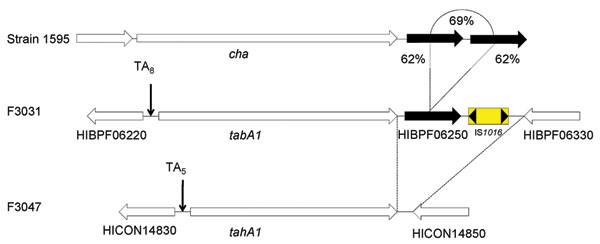Volume 18, Number 3—March 2012
Research
Lineage-specific Virulence Determinants of Haemophilus influenzae Biogroup aegyptius
Figure 7

Figure 7. Comparison of the cha locus from Haemophilus cryptic genospecies strain 1595 to the TabA1 locus in the Brazilian purpuric fever (BPF) clone of H. influenzae biogroup aegyptius (HaeBPF) F3031 and the TahA1 locus in H. influenzae biogroup aegyptius (Hae) conjunctivitis (CON) F3047. Strain F3031 includes an additional 2 coding sequences downstream of tabA1, HIBPF06250 and IS1016, that are absent from strain F3047. HIBPF06250 is a conserved hypothetical protein with homology (62% aa identity) to the 2 coding sequences located directly downstream of cha that share 69% aa identity with each other.
1Current affiliation: Stanford University, Palo Alto, California, USA.
Page created: February 16, 2012
Page updated: February 16, 2012
Page reviewed: February 16, 2012
The conclusions, findings, and opinions expressed by authors contributing to this journal do not necessarily reflect the official position of the U.S. Department of Health and Human Services, the Public Health Service, the Centers for Disease Control and Prevention, or the authors' affiliated institutions. Use of trade names is for identification only and does not imply endorsement by any of the groups named above.